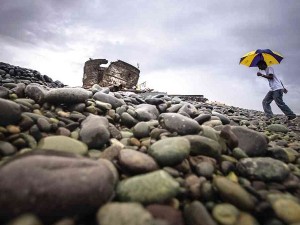In La Union, a pebble-rich town embraces bad weather

The pebbled beach of Luna, La Union has provided residents a good source of livelihood that officials said is also becoming a threat to village shorelines. RICHARD BALONGLONG/INQUIRER NORTHERN LUZON
LUNA, La Union–Storms generally wreak havoc on lives and property. But this seaside town embraces bad weather because its residents prosper from the colorful pebbles and stones that wash ashore after a storm.
“We are happy here when there is a storm because it would mean more stones,” said Diane Orpilla, La Union provincial environment and natural resources officer.
Stone picking is the main industry of the 14 villages of Luna, named not after the moon that gently illuminates the stone beaches at night but after artist Juan Luna.
The Luna stones are sediments borne by Amburayan River as it flows into interior La Union and exits through a delta in Bangar town, said Egbert Abiad, project manager of AMH Philippines Inc., an engineering consultancy firm, which conducted a study of the area.
“But the stones in Amburayan River are all gray and undersized, which are good aggregates. These probably come from Pasuquin River or other rivers up north in Ilocos Norte,” Abiad said.
Mary Jane Ortega, ex-mayor of San Fernando City, said there are no rivers or beaches in northern Luzon that are known to be sources of the Luna stones.
“They are metamorphic stones,” Abiad said.
But where they change into yellow, blue or green pebbles and stones is still a mystery, Ortega said.
“There must be some kind of long, geologic process” involved in the stones’ color transformation, she said.
The accepted theory here is that the stones are “sediments that flow down to the delta from Amburayan River during typhoons of several years back.”
Residents are also baffled by how stones seem to assemble themselves according to their colors. The beach has patches of red and blue because of this phenomenon.
Also bewildering to residents is the reaction of stones when they are removed from the beach—they lose luster.
While there appears to be an abundance of stones, over-extraction has hurt villages hit by erosions. The iconic baluarte (watchtower) on the town’s shores was split when the ground on which it stood began to weaken, according to the AMH study.














